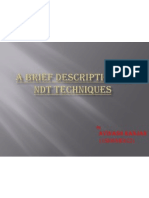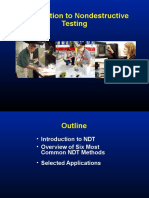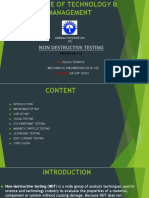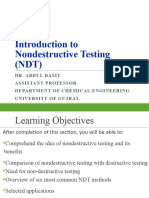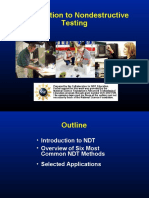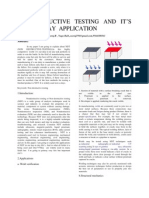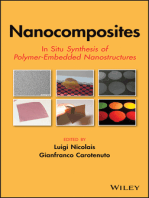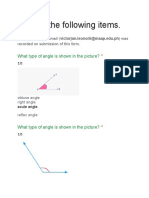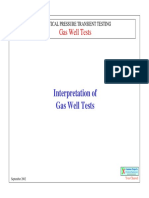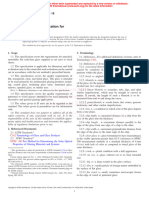0 ratings0% found this document useful (0 votes)
72 viewsNondestructive Testing
Nondestructive testing (NDT) uses analysis techniques like ultrasonic testing, magnetic particle inspection, dye penetrant inspection, radiographic testing, eddy-current testing, and optical interferometry to evaluate materials and systems without damaging them. Common NDT methods detect internal flaws, characterize materials, determine thickness, and locate surface-breaking defects. Because NDT does not alter the test object, it is a highly valuable technique that can lower costs and speed up product evaluation, troubleshooting, and research.
Uploaded by
Joby Jobzz SebellinoCopyright
© © All Rights Reserved
Available Formats
Download as PPTX, PDF, TXT or read online on Scribd
0 ratings0% found this document useful (0 votes)
72 viewsNondestructive Testing
Nondestructive testing (NDT) uses analysis techniques like ultrasonic testing, magnetic particle inspection, dye penetrant inspection, radiographic testing, eddy-current testing, and optical interferometry to evaluate materials and systems without damaging them. Common NDT methods detect internal flaws, characterize materials, determine thickness, and locate surface-breaking defects. Because NDT does not alter the test object, it is a highly valuable technique that can lower costs and speed up product evaluation, troubleshooting, and research.
Uploaded by
Joby Jobzz SebellinoCopyright
© © All Rights Reserved
Available Formats
Download as PPTX, PDF, TXT or read online on Scribd
You are on page 1/ 12
NONDESTRUCTIVE TESTING
NONDESTRUCTIVE TESTING
Nondestructive testing or Non-destructive testing (NDT) is a
wide group of analysis techniques used in science and industry
to evaluate the properties of a material, component or system
without causing damage.[1] The terms Nondestructive
examination (NDE),Nondestructive inspection (NDI),
and Nondestructive evaluation (NDE) are also commonly used
to describe this technology.[2] Because NDT does not
permanently alter the article being inspected, it is a highly-
valuable technique that can save both money and time in
product evaluation, troubleshooting, and research. Common
NDT methods include ultrasonic, magnetic-particle, liquid
penetrant, radiographic, remote visual inspection (RVI
ULTRASONIC TESTING
In ultrasonic testing (UT), very short ultrasonic pulse-
waves with center frequencies ranging from 0.1-
15 MHz and occasionally up to 50 MHz are launched
into materials to detect internal flaws or to
characterize materials. The technique is also
commonly used to determine the thickness of the test
object, for example, to monitor pipework corrosion.
Ultrasonic testing is often performed on steel and
other metals and alloys, though it can also be used on
concrete, wood and composites, albeit with less
resolution. It is a form of non-destructive testing used
in many industries including aerospace, automotive
and other transportation sectors.
MAGNETIC-PARTICLE INSPECTION
Magnetic particle inspection (MPI) is a
non-destructive testing (NDT) process for detecting
surface and subsurface discontinuities in
ferroelectric materials such as iron, nickel, cobalt, and
some of their alloys. The process puts a magnetic field
into the part. The piece can be magnetized by direct or
indirect magnetization. Direct magnetization occurs
when the electric current is passed through the test
object and a magnetic field is formed in the material.
Indirect magnetization occurs when no electric current
is passed through the test object, but a magnetic field
is applied from an outside source. The magnetic lines of
force are perpendicular to the direction of the electric
current which may be either alternating current (AC) or
some form of direct current (DC) (rectified AC).
The presence of a surface or subsurface
discontinuity in the material allows the
magnetic flux to leak. Ferrous iron
particles are applied to the part. The
particles may be dry or in a wet
suspension. If an area of flux leakage is
present the particles will be attracted to
this area. The particles will build up at
the area of leakage and form what is
known as an indication. The indication
can then be evaluated to determine what
it is, what may have caused it, and what
action should be taken, if any.
DYE PENETRANT INSPECTION
Dye penetrant inspection (DPI), also called liquid
penetrant inspection (LPI) or penetrant
testing (PT), is a widely applied and low-cost
inspection method used to locate surface-breaking
defects in all non-porous materials (metals,
plastics, or ceramics). The penetrant may be
applied to all non-ferrous materials and ferrous
materials, although for ferrous components
magnetic-particle inspection is often used instead
for its subsurface detection capability. LPI is used
to detect casting, forging and welding surface
defects such as hairline cracks, surface porosity,
leaks in new products, and fatigue cracks on in-
service components.
RADIOGRAPHIC TESTING
Radiographic Testing (RT), or
industrial radiography, is a
nondestructive testing (NDT) method of
inspecting materials for hidden flaws by using
the ability of short wavelength
electromagnetic radiation (high energy photons)
to penetrate various materials.
Either an X-ray machine or a radioactive source (
Ir-192, Co-60, or in rare cases Cs-137) can be
used as a source of photons.
Neutron radiographic testing (NR) is a variant of
radiographic testing which
uses neutrons instead of photons to
penetrate materials. This can see very
different things from X-rays, because
neutrons can pass with ease through lead
and steel but are stopped by plastics, water
and oils.
Since the amount of radiation emerging from
the opposite side of the material can be
detected and measured, variations in this
amount (or intensity) of radiation are used
to determine thickness or composition of
material. Penetrating radiations are those
restricted to that part of the
electromagnetic spectrum of wavelength
less than about 10 nanometres.
EDDY-CURRENT TESTING
Eddy-current testing uses
electromagnetic induction to detect flaws in
conductive materials. There are several
limitations, among them: only conductive
materials can be tested, the surface of the
material must be accessible, the finish of the
material may cause bad readings, the depth
of penetration into the material is limited by
the materials' conductivity, and flaws that lie
parallel to the probe may be undetectable.
In a standard eddy current testing a circular coil
carrying current is placed in proximity to the test
specimen (which must be electrically
conductive).The alternating current in the coil
generates changing magnetic field which interacts
with test specimen and generates eddy
current.Variations in the phase and magnitude of
these eddy currents can be monitored using a
second 'receiver' coil, or by measuring changes to
the current flowing in the primary 'excitation' coil.
Variations in the electrical conductivity or magnetic
permeability of the test object, or the presence of
any flaws, will cause a change in eddy current and
a corresponding change in the phase and amplitude
of the measured current. This is the basis of
standard (flat coil) eddy current inspection, the
most widely used eddy current technique.
However, eddy-current testing can detect
very small cracks in or near the surface of
the material, the surfaces need minimal
preparation, and physically complex
geometries can be investigated. It is also
useful for making electrical conductivity
and coating thickness measurements.
The testing devices are portable, provide
immediate feedback, and do not need to
contact the item in question. Recently
tomographic notion of ECT has been
explored see for example:
OPTICAL INTERFEROMETRY
Optical interferometry combines two or more light
waves in an optical instrument in such a way that
interference occurs between them.
Early interferometers used white light sources and also
monochromatic light from atomic sources (e.g.,
Young's double slit experiment of 1805) . Such
interferometers had a wide range of applications, for
example, calibration of slip gauges and measurement of
gas flow.[1] In 1960, when the definition of the meter
was based on one of the spectral line emitted by
krypton-86, interferometry was essential in setting up
the standard. The development of lasers has made it
much easier to produce optical interference and has led
to the development of a wide range of measurement
methods in engineering, physics and other fields.
You might also like
- FREE Alpha One OC Trial Test Paper Worked SolutionsNo ratings yetFREE Alpha One OC Trial Test Paper Worked Solutions61 pages
- Bending Moment Coefficients For Rectangular Slabs Supported On Four Sides Based On Table 7.3.2 AS3600No ratings yetBending Moment Coefficients For Rectangular Slabs Supported On Four Sides Based On Table 7.3.2 AS360033 pages
- Amit Golait Poonam Kanojia: Presented ByNo ratings yetAmit Golait Poonam Kanojia: Presented By23 pages
- Note CHP 6 Material Science 281 Uitm Em110No ratings yetNote CHP 6 Material Science 281 Uitm Em11045 pages
- Introduction To Non Destructive Testing (NDT) : BY Rsa Academy SDN BHDNo ratings yetIntroduction To Non Destructive Testing (NDT) : BY Rsa Academy SDN BHD39 pages
- Non Destructive Testing::Akash Tripathi Mechanical Engineering (2014-18:D41 (4 Year)No ratings yetNon Destructive Testing::Akash Tripathi Mechanical Engineering (2014-18:D41 (4 Year)29 pages
- Pengenalan NDT (Non Distruktif Testing)No ratings yetPengenalan NDT (Non Distruktif Testing)34 pages
- Introduction To Non Destructive Testing (NDT)No ratings yetIntroduction To Non Destructive Testing (NDT)35 pages
- The Engineers EDGE - INTRO NDT - Webinar Session100% (2)The Engineers EDGE - INTRO NDT - Webinar Session59 pages
- Ergonomics & Industrial Safety Ii-Tie 1204: Non-Destructive Testing (NDT)No ratings yetErgonomics & Industrial Safety Ii-Tie 1204: Non-Destructive Testing (NDT)35 pages
- What Is NDT ?: Detection of Damage Before BreakdownNo ratings yetWhat Is NDT ?: Detection of Damage Before Breakdown40 pages
- Laser Metrology in Fluid Mechanics: Granulometry, Temperature and Concentration MeasurementsFrom EverandLaser Metrology in Fluid Mechanics: Granulometry, Temperature and Concentration MeasurementsNo ratings yet
- Guidelines for the Determination of Standardized Semiconductor Radiation Hardness ParametersFrom EverandGuidelines for the Determination of Standardized Semiconductor Radiation Hardness ParametersNo ratings yet
- New Sensors and Processing ChainFrom EverandNew Sensors and Processing ChainJean-Hugh ThomasNo ratings yet
- Non-Destructive Evaluation of Corrosion and Corrosion-assisted CrackingFrom EverandNon-Destructive Evaluation of Corrosion and Corrosion-assisted CrackingNo ratings yet
- Nanocomposites: In Situ Synthesis of Polymer-Embedded NanostructuresFrom EverandNanocomposites: In Situ Synthesis of Polymer-Embedded NanostructuresLuigi NicolaisNo ratings yet
- Impedance Spectroscopy: Applications to Electrochemical and Dielectric PhenomenaFrom EverandImpedance Spectroscopy: Applications to Electrochemical and Dielectric Phenomena5/5 (1)
- Nanoelectronics Devices: Design, Materials, and Applications (Part II)From EverandNanoelectronics Devices: Design, Materials, and Applications (Part II)No ratings yet
- Phys101 Lecture 6 Circular Motion: Key PointsNo ratings yetPhys101 Lecture 6 Circular Motion: Key Points11 pages
- C1 - L4 The Self West and East ThoughtsNo ratings yetC1 - L4 The Self West and East Thoughts17 pages
- What Is Team Sport in Your Own UnderstandingNo ratings yetWhat Is Team Sport in Your Own Understanding4 pages
- Reflection Paper: Christian J C. Sebellino Bsce-2ANo ratings yetReflection Paper: Christian J C. Sebellino Bsce-2A1 page
- What Is Team Sport in Your Own UnderstandingNo ratings yetWhat Is Team Sport in Your Own Understanding4 pages
- Industrial Products Division: Kurashiki Kako Co., Ltd. Kurashiki Kako Co., LTDNo ratings yetIndustrial Products Division: Kurashiki Kako Co., Ltd. Kurashiki Kako Co., LTD32 pages
- Approximate Traveling Wave Solution of Avian FluNo ratings yetApproximate Traveling Wave Solution of Avian Flu6 pages
- Microsoft PowerPoint - 06-Gas Well Testing - PPT (Read-Only)No ratings yetMicrosoft PowerPoint - 06-Gas Well Testing - PPT (Read-Only)14 pages
- Paper - 2013 - Dam Break Analysis Applied To Tailings DamsNo ratings yetPaper - 2013 - Dam Break Analysis Applied To Tailings Dams28 pages
- Mohammed and Barbosa - Numerical Modeling Strategy For The Simulation of Nonlinear Response of Slender Reinforced Concrete Structural WallsNo ratings yetMohammed and Barbosa - Numerical Modeling Strategy For The Simulation of Nonlinear Response of Slender Reinforced Concrete Structural Walls45 pages
- Assignment 2: Engineering Graphics - CAD / 19MEE100No ratings yetAssignment 2: Engineering Graphics - CAD / 19MEE1002 pages
- A Capillary Viscometer For Characterization of Fluid FoodsNo ratings yetA Capillary Viscometer For Characterization of Fluid Foods5 pages
- Fluid Mechanics - 100 Problems-CompressedNo ratings yetFluid Mechanics - 100 Problems-Compressed26 pages
- Balanced and Unbalanced Forces Class ActivityNo ratings yetBalanced and Unbalanced Forces Class Activity6 pages
- Finite Element Analysis of Natural Whirl Speeds of Rotating ShaftsNo ratings yetFinite Element Analysis of Natural Whirl Speeds of Rotating Shafts7 pages
- FREE Alpha One OC Trial Test Paper Worked SolutionsFREE Alpha One OC Trial Test Paper Worked Solutions
- Bending Moment Coefficients For Rectangular Slabs Supported On Four Sides Based On Table 7.3.2 AS3600Bending Moment Coefficients For Rectangular Slabs Supported On Four Sides Based On Table 7.3.2 AS3600
- Introduction To Non Destructive Testing (NDT) : BY Rsa Academy SDN BHDIntroduction To Non Destructive Testing (NDT) : BY Rsa Academy SDN BHD
- Non Destructive Testing::Akash Tripathi Mechanical Engineering (2014-18:D41 (4 Year)Non Destructive Testing::Akash Tripathi Mechanical Engineering (2014-18:D41 (4 Year)
- Ergonomics & Industrial Safety Ii-Tie 1204: Non-Destructive Testing (NDT)Ergonomics & Industrial Safety Ii-Tie 1204: Non-Destructive Testing (NDT)
- What Is NDT ?: Detection of Damage Before BreakdownWhat Is NDT ?: Detection of Damage Before Breakdown
- Laser Metrology in Fluid Mechanics: Granulometry, Temperature and Concentration MeasurementsFrom EverandLaser Metrology in Fluid Mechanics: Granulometry, Temperature and Concentration Measurements
- Guidelines for the Determination of Standardized Semiconductor Radiation Hardness ParametersFrom EverandGuidelines for the Determination of Standardized Semiconductor Radiation Hardness Parameters
- Non-Destructive Evaluation of Corrosion and Corrosion-assisted CrackingFrom EverandNon-Destructive Evaluation of Corrosion and Corrosion-assisted Cracking
- Nanocomposites: In Situ Synthesis of Polymer-Embedded NanostructuresFrom EverandNanocomposites: In Situ Synthesis of Polymer-Embedded Nanostructures
- Impedance Spectroscopy: Applications to Electrochemical and Dielectric PhenomenaFrom EverandImpedance Spectroscopy: Applications to Electrochemical and Dielectric Phenomena
- Nanoelectronics Devices: Design, Materials, and Applications (Part II)From EverandNanoelectronics Devices: Design, Materials, and Applications (Part II)
- Reflection Paper: Christian J C. Sebellino Bsce-2AReflection Paper: Christian J C. Sebellino Bsce-2A
- Industrial Products Division: Kurashiki Kako Co., Ltd. Kurashiki Kako Co., LTDIndustrial Products Division: Kurashiki Kako Co., Ltd. Kurashiki Kako Co., LTD
- Microsoft PowerPoint - 06-Gas Well Testing - PPT (Read-Only)Microsoft PowerPoint - 06-Gas Well Testing - PPT (Read-Only)
- Paper - 2013 - Dam Break Analysis Applied To Tailings DamsPaper - 2013 - Dam Break Analysis Applied To Tailings Dams
- Mohammed and Barbosa - Numerical Modeling Strategy For The Simulation of Nonlinear Response of Slender Reinforced Concrete Structural WallsMohammed and Barbosa - Numerical Modeling Strategy For The Simulation of Nonlinear Response of Slender Reinforced Concrete Structural Walls
- Assignment 2: Engineering Graphics - CAD / 19MEE100Assignment 2: Engineering Graphics - CAD / 19MEE100
- A Capillary Viscometer For Characterization of Fluid FoodsA Capillary Viscometer For Characterization of Fluid Foods
- Finite Element Analysis of Natural Whirl Speeds of Rotating ShaftsFinite Element Analysis of Natural Whirl Speeds of Rotating Shafts













